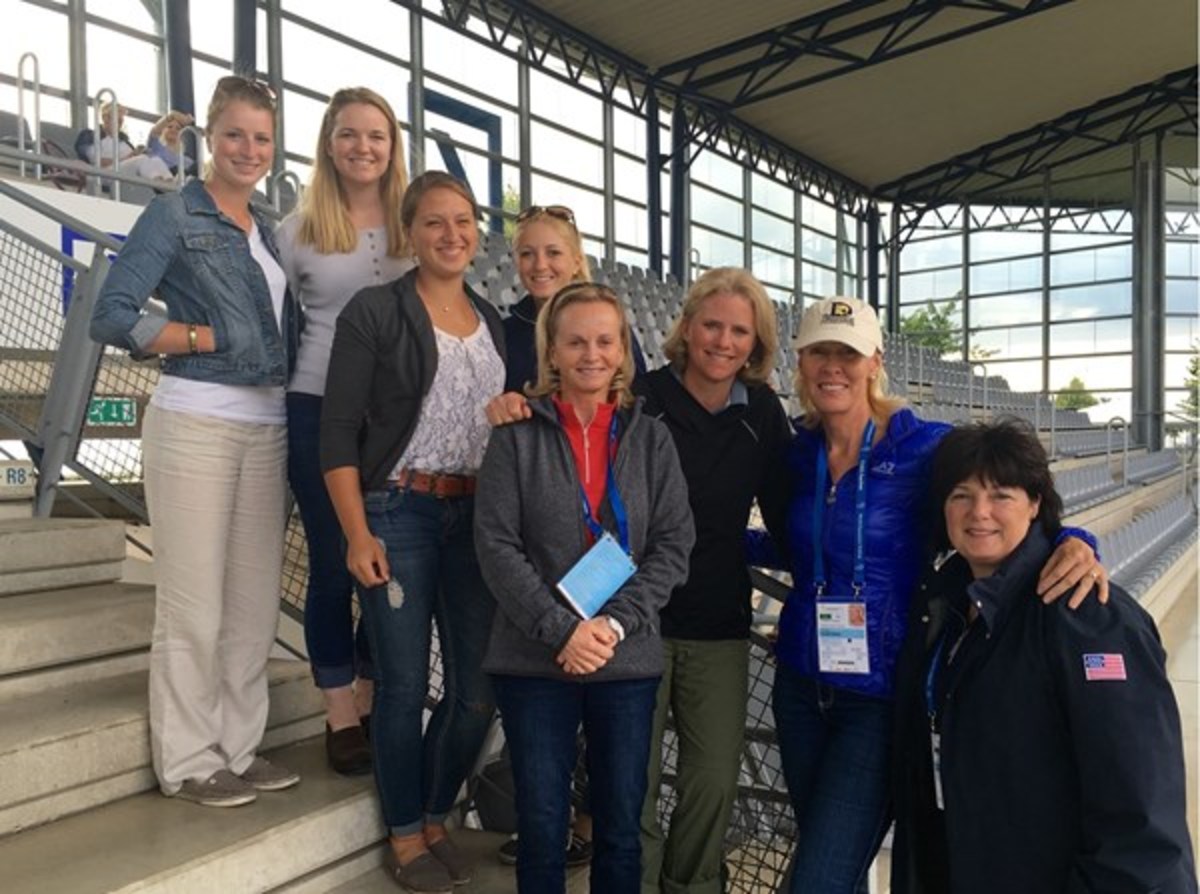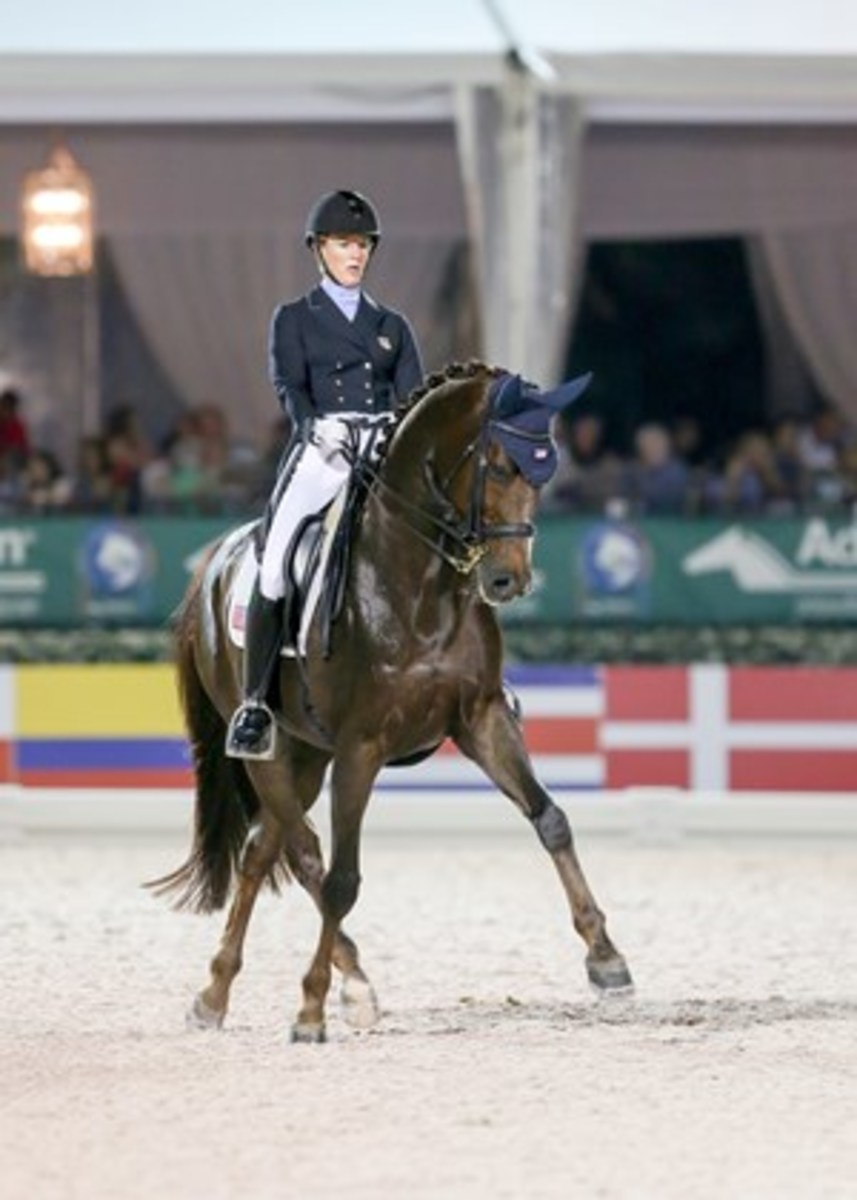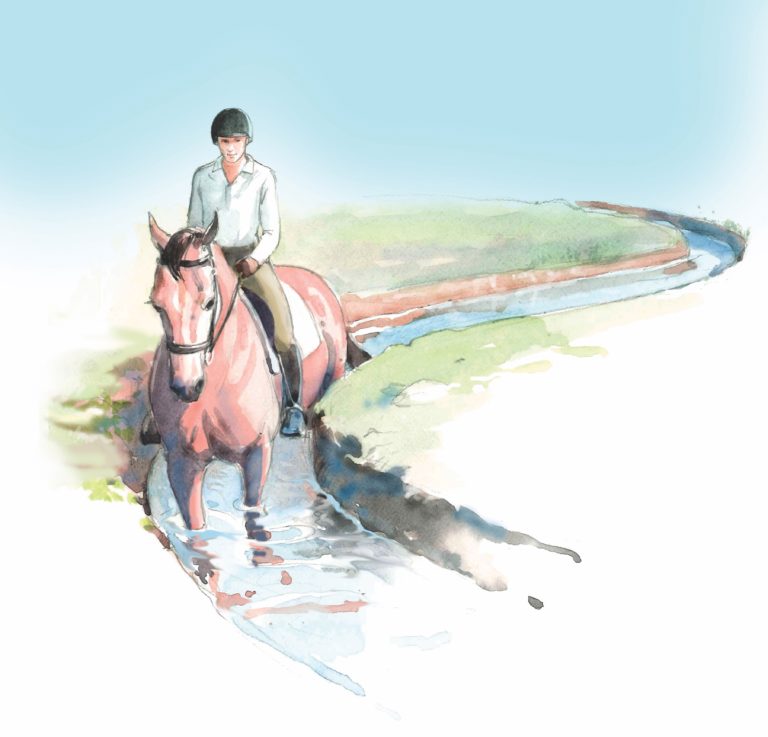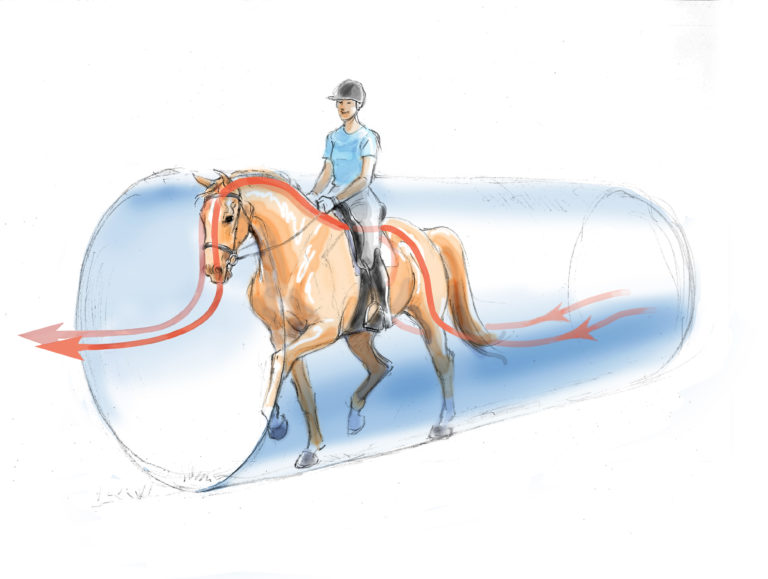
Every year, The Dressage Foundation’s (TDF) International Dream Program sends four Young Riders to Europe to observe the European training system, visit with international judges and trainers and watch the top horses and riders in the world. Participants are chosen for their experience and high level of commitment to the sport of dressage.
This year, the four of us were selected to attend the World Equestrian Festival in Aachen, Germany, with chaperones Jennifer Verharen and Charlotte Bredahl-Baker. We spent a week completely absorbed in this world of international dressage competition and, thanks to Charlotte, we spent time talking with many trainers and riders who we ordinarily would never even have had the chance to meet. For a week, we were immersed in dressage and learned from the very best. Now that we have arrived home, we are more motivated than ever and armed with new knowledge about how to advance our own training and careers. Here are some of the highlights that we were able to fit in our bags for the plane ride home.

1. Shortcuts Get You Nowhere (Emily Gill)
We spent our first day in Aachen watching each nation’s team schooling in the competition arena. It became obvious right away that some of the horses could go through an entire warm-up without any loss of the basics while others would lose relaxation and rhythm as they began the collected work. We could really see where some shortcuts had been taken or where horses were not quite confirmed at the level. Cathrine Dufour of Denmark and her horse, Cassidy, were fantastic examples of quality training in which no shortcuts had been taken. Cassidy started out looking like a wonderfully relaxed Training Level horse at the beginning of their warm-up and finished looking like the top Grand Prix horse he is without signs of tension or loss of connection. It was like watching the Training Scale come to life in front of our eyes!
On the other hand, we also saw riders who were not able to develop collection quite so smoothly. As they started the piaffe and passage work, we could see tension creep in. The horse’s back would tighten, the tail would start to swish and sometimes the mouth would open. These were obvious signs that perhaps these horses needed more time training in order to produce high-quality Grand Prix work and that maybe some steps in the training had been skipped. Not only do Grand Prix horses need to perform beautiful movements, they should also want to perform them. The top combinations were beautiful examples of this.
2. Every Person Has His Own Unique Journey (Emily Gill)
From the time we got off the plane, we met respected riders and trainers from all over the world. We got to know a bit about the personal journeys of the U.S. riders. Katherine Bateson-Chandler, for example, had few resources but worked hard as a groom for Robert Dover for many years. Her personal drive and love for her horses kept her going even through times of struggle. What a thrill to see her now, riding at Aachen with her own sponsor and being coached by Carl Hester.
Laura Graves told us about the moment she was about to give it all up. She had traveled the country alone, competing on a horse she’d trained herself and was receiving very little recognition for her efforts. In a last-ditch attempt to get support, she applied to be observed by the U.S. coaches and finally connected with Debbie McDonald. This made all the difference for her and she and Verdades have been excelling ever since. Laura is representing our country now because she didn’t give up when she was at her lowest point.
Alison Brock started riding as a little kid and competed in a variety of disciplines including Western and jumpers. She was also a hardworking groom for Sue Blinks for many years. She told us about her difficult transition to Grand Prix with Rosevelt and how many people thought they wouldn’t make it. It took lots of time and patience to bring him to the point where he is now—representing the U.S. in the Olympics.
It was really motivating for me to hear these stories. There was a point toward the end of the week when I was looking over the hedges into the warm-up, standing just feet away from Olympic-level riders and horses. I said to our chaperone Jennifer, “I feel like I can relax a little now in my own journey to be the best. There’s no formula I need to follow. It just takes hard work and determination. I can do it in my own way and there’s no secret code to getting there.” We each have our own path.
3. Buy Young and Affordable Horses (Rebekah Mingari)
A common thread among those we talked with is the idea that trainers or riders should look for affordable young horses when searching for their next partner. Buying horses young requires a smaller initial investment. It also allows the rider to do all of the training in his or her own way. Juan Matute, Sr. advised us to buy horses young and develop them ourselves. He believes it is wiser to invest in educating a young prospect than to buy a schoolmaster. It’s much more rewarding to ride down centerline on a horse you made yourself than on a horse who was educated before you purchased it. He said that when showing a schoolmaster, every mistake is more expensive than when you’re showing a horse you’ve trained yourself. Mistakes are part of the training process so there is always a lot to learn from them.
He explained that when looking for the right horse, temperament is often overlooked. Most people who buy horses look for a balanced walk and canter and a “nice enough” trot because the trot can be improved with training. But in reality, the temperament of the horse should match the temperament of the rider. An ambitious rider will not achieve her goals with a laid-back or lazy horse. A hot horse will not do well for a timid rider. The personalities of the rider and horse should match in order to create a positive and successful relationship.
4. Dressage is a People Sport (Rebekah Mingari)
When I was in high school, I thought I wanted to be a horse trainer because I would only have to deal with horses every day—not people. Little did I realize how important people are to making even one horse successful. We work with clients, students, judges, trainers, employers, vets, farriers and all other equine professionals on a daily basis.
Katherine reminded us that we need to be genuine with people and that it is most important to be ourselves. Watching Charlotte interact with the people she introduced us to helped me realize that this sport is never not about people. Charlotte is such a genuine person and truly loves the people she is surrounded by. And it’s obvious that they love her, too! Katherine reminded me that I need to work on my people skills. This can be as simple as asking questions, being truly interested in other people’s lives and being a good listener.
5. How to Achieve Harmony-
(Rachel Chowanec)
Many of us watch top horse-and-rider combinations and think, Wow, that is so impressive. It looks beautiful! This was certainly the case for me in Aachen. I saw so many incredible, harmonious partnerships. More important, though, I gained a better understanding of how to achieve this kind of harmony with my own horses. It’s easy to get stuck on a movement, knowing something doesn’t feel correct, and yet struggle to make it happen. At Aachen we saw many combinations that appeared to be doing a beautiful dance. We also saw them working through transitions and exercises during the warm-up in order to then be able to dance in the ring. My main question for the riders and trainers we spoke with was: How do you achieve such harmony? Steffen Peters stressed the importance of keeping the horse supple and reaching for the contact. He said even when he asks for more expression, he goes right back to suppling in the next moment. He said this increases the harmony between horse and rider. Bo Jena, coach of the Swedish dressage team, talked about improving harmony by working a horse on the long lines. He said you can often see more quickly than you can feel what’s happening with a horse.
6. Don’t Overwork the Horses! (Rachel Chowanec)
We sometimes hear that you need to work a horse for at least 45 minutes. Well, that is most certainly not the case. Many top trainers and riders at Aachen said they take their horses out and walk first. Then they do a little stretching and work the horse for maybe 25 minutes. That may not be all the horse will do that day as many of these top professionals tack walk and hack as well, but they do not overwork in the ring. This keeps the horse fit, yet happy to be working with you. Lots of horses do not need constant drilling. Many top trainers such as Carl, Debbie, and Steffen believe this is key to top-quality training.
7. How to Start the Piaffe and Passage (Lillian Simons)
We were lucky to spend quite a bit of time with Christoph Hess, a well-respected judge and trainer from Germany. He spoke at great length about teaching the piaffe and passage. He started with the responsibilities of the rider and emphasized that details, even minor ones, should be an important focus. Without attention to detail, he said, riders do not have the concentration and, subsequently the skill, to reach the top of the sport. The basics need to be emphasized the most.
Christoph also said that patience is a must. We often hear that patience is vital in this sport, but he managed to broaden its importance. For instance, having patience means taking the time to stop and notice the horse’s body language and signals when training. The piaffe and passage are not easy movements for horses to perform under saddle. This means that it is the rider’s responsibility to look carefully at the horses and understand their body language and subtle cues. This includes noticing tightness in the back, unsteadiness in the contact, heavy breathing, the degree to which they’re sweating, the look in their eyes and how they carry their tails. Body language, he said, is even more important than paying attention to the technical aspects of training. The rider must have a feeling for and understanding of relaxation. The ability to feel the horse ultimately leads to greater understanding and sensitivity.
In addition to feeling, sensitivity and attention to detail, contact and true connection were focal points. Riding back to front is imperative for Christoph. When we restrict the connection and the natural energy flow of the horse, we create tightness in the back and a lazy hind leg. This works against the nature of the horse. The rider’s hands should always move in the direction of the horse’s mouth to allow the body to move naturally. Seeking the contact is paramount. When we allow the horse to reach into the contact, there’s a degree of evenness throughout the entire body and then the horse moves properly.
Christoph explained the training methods he uses to introduce piaffe and passage. He has these most collected movements in mind when he begins training young horses as 3- or 4-year- olds. “Transitions,” he said, “are key during every stage of a horse’s education. Back-and-forth transitions between walk and trot develop the spirit of training piaffe.” It is the rider’s responsibility to ride forward in downward transitions from, for example, trot into walk. The horse must swing into the walk and the rider should feel every step of the transition, as if it’s occurring in slow motion. The trot rhythm must be maintained in the downward transition until the rider wants walk. When the rider is able to go from trot to walk without using the reins then he or she is moving toward positive results. Once this downward transition is reliable, the rider must, within the same transition of trot to walk, catch the horse just as he approaches the walk so that he begins to understand the feeling of trotting “on the spot.” Once the horse begins to understand this concept, Christoph says it’s time to have someone from the ground assist the rider.
He emphasized how important it is to understand that the piaffe is not a trick. It is a perfection of the half halt and should be done as a part of the gymnastic series in a horse’s education. The piaffe must be schooled delicately—it’s not for the circus!
8. Dressage Takes a Village
(Lillian Simons)
We were fortunate to speak with U.S. dressage team supporter, Betsy Juliano, who discussed the fundamentals of achieving sponsorship. She talked about the importance of being well-rounded athletes who represent both themselves and their country admirably in every situation. She described how opportunities often surprise you. Her involvement in sponsorship was not initially planned or possible, but circumstances have allowed her to become deeply involved with the development of the U.S. dressage team and riders. Her most important advice was to always be aware of how you behave under pressure, no matter the situation. How a person responds to unfortunate circumstances, how he or she handles themselves and how he or she treats other people and their horses are the things that stand out and leave a lasting impression. She also spoke about how important reputation is. She said you’re always building your reputation one way or another. You never know if someone you come into contact with one day will be in a position to sponsor you the next. How you behave in public, how you dress, how you present yourself resonate with the people around you and will always leave a lasting impression.
American rider Tuny Page talked about being a competitor. She shared a list of quotes that serve as a source of inspiration for her when she is competing and training: “I’m focused on the process, not the outcome,” she said.

Tuny’s most important point was about attitude. She said it’s imperative that we live with an “attitude of gratitude.” We each have our own village of people who have worked tirelessly to help us get where we are. We must show them how much their sacrifice and hard work mean to us—whether it’s our vet, farrier, coach or family. Be sure to check in with your village regularly and tell them how much you appreciate their hard work. Never assume they know how thankful you are—show them. Being truly grateful for what others are doing for you will lead to a supportive team and happy, positive atmosphere.
This was the trip of a lifetime for us. Please support TDF in any way you can so that more Young Riders will be able to experience what we did. It was not only about the things we saw but the people we met and the new relationships we made. We all have new forever friends. Thanks to chaperones Jennifer and Charlotte and thank you to everyone from TDF for making this dream come true. We can’t wait to go out and use everything we’ve learned!











